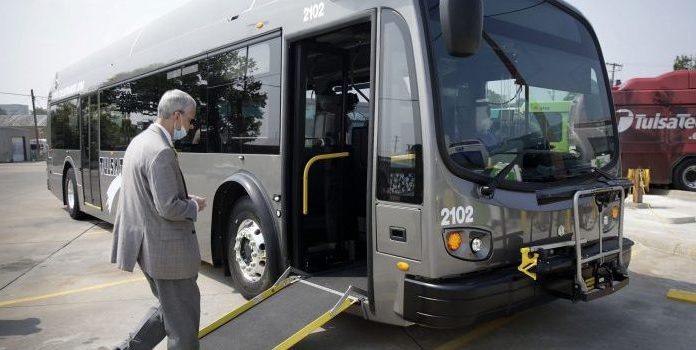(Headline USA) Public transit systems straining to win back riders after being crushed by the COVID-19 pandemic are getting a $3.7 billion boost to stay afloat and invest in new fleets of electric buses, despite the fact that transit ridership was already in decline before the drop associated with COVID.
With mask restrictions fading and workers beginning to return to offices, the Biden administration said Monday it was awarding $2.2 billion in coronavirus relief funding to 35 financially strapped transit agencies in 18 states. The money would be used to prop up day-to-day operations, including staffing and payroll as well as cleaning and sanitization to limit the spread of illness in public transportation. A federal mask mandate for public transit remains in effect until at least March 18.
While Biden’s solution is to throw scads of money at any problem created by government in order to fix it, the cash flow usually does little to help. In fact, it can often end up creating even more problems, as exhibited by the gross abuse in fraud and waste of COVID cash that already taken place.
Another $1.5 billion in grants will be available under President Joe Biden’s infrastructure law — a total of $7.5 billion over five years — for transit agencies to purchase low- or no-emission buses and build bus facilities. That’s more than double the combined amount from the previous year. How that will assist in getting ridership numbers back on track is anybody’s guess, but it certainly helps shore up some support from Biden’s green base.
Transit agencies will have until May to apply for the Transportation Department‘s infrastructure grants, which will be awarded by fall. About 5% of the money must be used for workforce training to help transit workers prepare for the technological change.
“We’re making the largest ever investment in this program for buses and bus facilities, helping to deliver better commutes and cleaner air to American communities,” Transportation Secretary Pete Buttigieg said.
Buttigieg was joining Vice President Kamala Harris, who has pushed the need for electric school buses, along with EPA Administrator Michael Regan and other officials at the White House on Monday. They were unveiling efforts to promote green-friendly transit and announcing a proposed rule aimed at reducing emissions from dirty diesel trucks. Transportation is the biggest U.S. contributor to global warming.
Several transit systems already are moving in the direction of electric buses. California has committed to all-electric bus fleets by 2040, as well as New York City and Boston. Washington, D.C., has set a target of 2045.
The effort comes at a challenging time for public transit.
Only about 55% of transit riders nationwide have returned compared with pre-pandemic times, according to the American Public Transportation Association. The biggest losses have been in commuter rail systems serving white-collar suburbanites traveling to downtown workplaces.
As COVID-19 cases decline, Biden has urged Americans to shed remote work, describing a return to offices as necessary to boost economic growth. Last week, the Centers for Disease Control and Prevention said about 90% of the U.S. population lives in counties where the risk of the coronavirus is posing a low or medium threat, meaning residents don’t need to wear masks in most indoor settings.
“It’s time for America to get back to work and fill our great downtowns again with people,” Biden said in his State of the Union address.
Among the recipients of COVID-19 relief funds Monday were big-city transit systems that had been hit hard from revenue losses due to decreased ridership. New York City’s transit system, the nation’s largest, garnered $769 million to steady its operations, while San Francisco’s Bay Area Rapid Transit got $270 million to bolster service and safety protocols.
Others receiving grants were the Washington, D.C., metro system at $120 million as it anticipates a return of federal employees to offices and Houston’s public transit at $137 million, which has significantly added rapid transit bus lines.
“These funds are crucial to avoid drastic service cuts and layoffs that would damage the economy and public health,” said Nuria Fernandez, head of the Federal Transit Administration, which oversees the grants.
At the start of the pandemic, transit agencies cut payroll and slashed services. That came even as essential workers, who are disproportionately nonwhite and lower income, continued to rely on public transportation to get to work. But three rounds totaling nearly $70 billion in federal COVID-19 emergency assistance, including $30.5 billion that Biden signed into law last year, pulled transit agencies from the brink of financial collapse.
“The COVID funds will be vital to keeping workers connected to their offices, but, even more importantly, the long-term funds in the bipartisan infrastructure bill will provide generational change,” said Paul P. Skoutelas, president of the American Public Transportation Association. He said the money will allow transit systems “to re-evaluate routes and service plans, address equity issues and place more alternative fuels vehicles on the road to help address our global climate crisis.”
Adapted from reporting by the Associated Press

